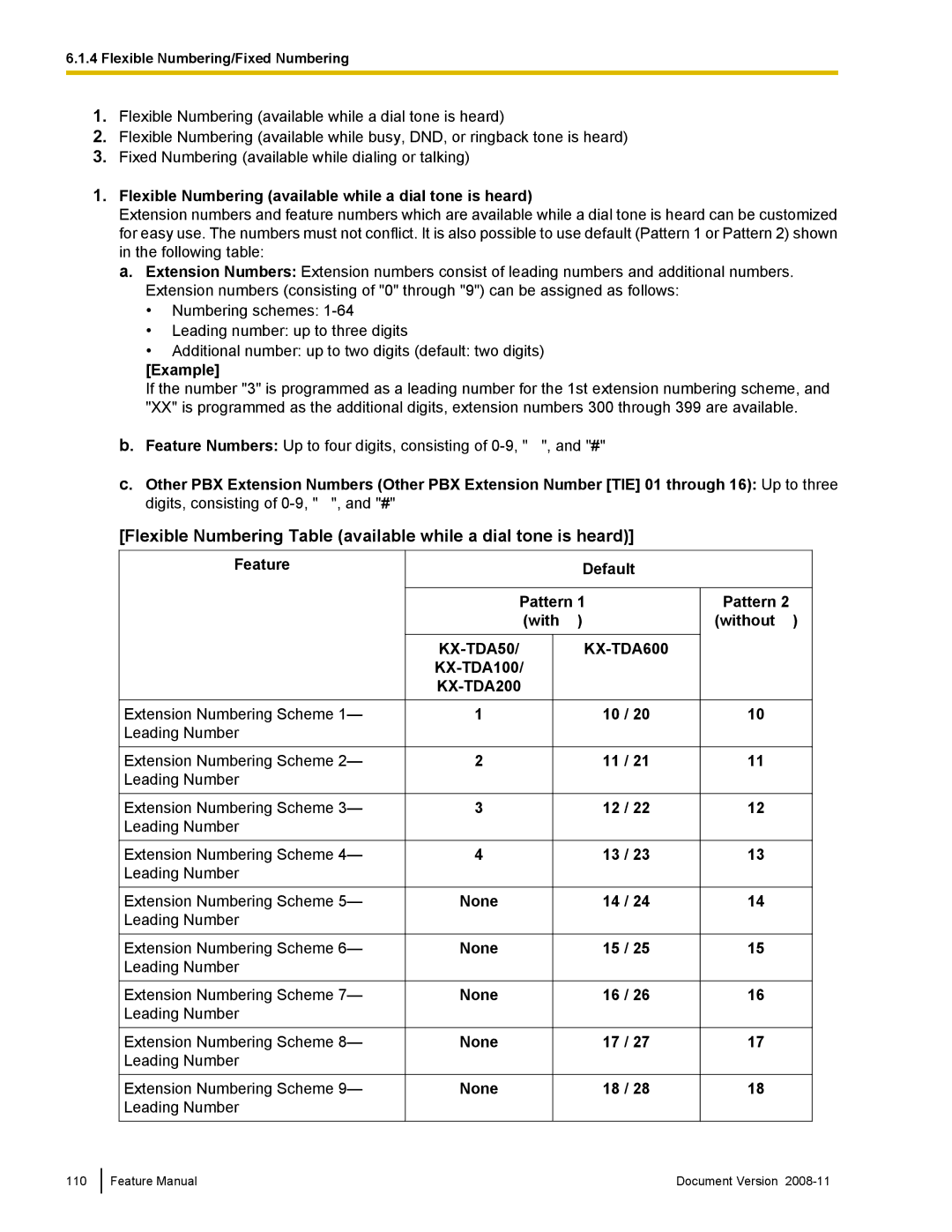
6.1.4Flexible Numbering/Fixed Numbering
1.Flexible Numbering (available while a dial tone is heard)
2.Flexible Numbering (available while busy, DND, or ringback tone is heard)
3.Fixed Numbering (available while dialing or talking)
1.Flexible Numbering (available while a dial tone is heard)
Extension numbers and feature numbers which are available while a dial tone is heard can be customized for easy use. The numbers must not conflict. It is also possible to use default (Pattern 1 or Pattern 2) shown in the following table:
a.Extension Numbers: Extension numbers consist of leading numbers and additional numbers. Extension numbers (consisting of "0" through "9") can be assigned as follows:
•Numbering schemes:
•Leading number: up to three digits
•Additional number: up to two digits (default: two digits)
[Example]
If the number "3" is programmed as a leading number for the 1st extension numbering scheme, and "XX" is programmed as the additional digits, extension numbers 300 through 399 are available.
b.Feature Numbers: Up to four digits, consisting of ![]() ", and "#"
", and "#"
c.Other PBX Extension Numbers (Other PBX Extension Number [TIE] 01 through 16): Up to three digits, consisting of ![]() ", and "#"
", and "#"
[Flexible Numbering Table (available while a dial tone is heard)]
Feature |
|
|
| Default |
|
| ||
|
|
|
|
|
|
|
| |
|
| Pattern 1 | Pattern 2 | |||||
|
| (with | ) |
| (without ) | |||
|
|
|
|
| ||||
|
|
|
|
|
|
| ||
|
|
|
|
|
|
| ||
|
|
|
|
|
|
|
|
|
Extension Numbering Scheme 1— | 1 |
|
| 10 / 20 |
| 10 |
| |
Leading Number |
|
|
|
|
|
|
| |
|
|
|
|
|
|
|
|
|
Extension Numbering Scheme 2— | 2 |
|
| 11 / 21 |
| 11 |
| |
Leading Number |
|
|
|
|
|
|
| |
|
|
|
|
|
|
|
|
|
Extension Numbering Scheme 3— | 3 |
|
| 12 / 22 |
| 12 |
| |
Leading Number |
|
|
|
|
|
|
| |
|
|
|
|
|
|
|
|
|
Extension Numbering Scheme 4— | 4 |
|
| 13 / 23 |
| 13 |
| |
Leading Number |
|
|
|
|
|
|
| |
|
|
|
|
|
|
|
|
|
Extension Numbering Scheme 5— | None |
| 14 / 24 |
| 14 |
| ||
Leading Number |
|
|
|
|
|
|
| |
|
|
|
|
|
|
|
|
|
Extension Numbering Scheme 6— | None |
| 15 / 25 |
| 15 |
| ||
Leading Number |
|
|
|
|
|
|
| |
|
|
|
|
|
|
|
|
|
Extension Numbering Scheme 7— | None |
| 16 / 26 |
| 16 |
| ||
Leading Number |
|
|
|
|
|
|
| |
|
|
|
|
|
|
|
|
|
Extension Numbering Scheme 8— | None |
| 17 / 27 |
| 17 |
| ||
Leading Number |
|
|
|
|
|
|
| |
|
|
|
|
|
|
|
|
|
Extension Numbering Scheme 9— | None |
| 18 / 28 |
| 18 |
| ||
Leading Number |
|
|
|
|
|
|
| |
|
|
|
|
|
|
|
|
|
110
Feature Manual | Document Version |
